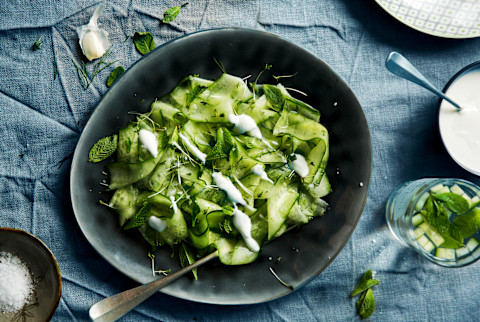
Even though plant-based eating is on the rise, many people still associate giving up meat, dairy, and eggs with monotonous meals and comfort food without the secret sauce that makes it so comforting. But that couldn't be further from the truth.
The reality is that you don't need to leave the exciting plant-based dishes to the chefs. Check out these seven flavor-deepening techniques you can try with plant-based cooking right at home—yep, even on those busy weeknights.
Begin with better ingredients.
It doesn't matter if you're an omnivore or a part-time pescatarian, 9-to-5 FODMAP hybrid—great food starts with great ingredients. When eating plant-based, try to source your produce from your local farmers markets or CSA boxes (find a CSA near you), and shop at stores that bring in local produce. Avoid buying out of season, but if you do, head to the freezer aisle for produce. They're frozen at the height of ripeness and nutrition (plus, it's cheaper that way, too). And if you can manage it, it's worth it to spend just a little bit more for quality oils and vinegars.
Make friends with spices, herbs, and tamari.
Your spice rack and your herb garden are your second line of defense for upping the flavor in your meals. Garnish dishes with finely chopped fresh parsley or cilantro to add a punch or zesty kick. For Indian or South Asian–inspired dishes, sprinkle in a mix of ground turmeric, cumin, ginger, and coriander. Add chili flakes to nearly any dish for a hit of heat. Or chop up fresh mint or dill (or both), and add it to your salad for a refreshing twist.
And if you haven't tried boosting flavor with tamari, plant-based meals are the perfect place to start. Tamari is a type of gluten-free soy sauce that tastes less salty than regular soy sauce. It's our food director's secret weapon when it comes to adding savory depth and an element of umami to foods and snacks that fall short flavor-wise.

Pick a favorite plant-based dairy alternative.
The world of dairy-free cheeses, yogurts, milks, and mayos is more wide-ranging than ever. With the days of weird, stiff cheese slices and sugar-loaded soy milks long over, don't be afraid to explore the plant-based dairy and cheese sections of your grocery store. Plant-based cheese especially has evolved enormously in the last few years, from shredded cheese to queso dips. You can now pretty much use it just like any dairy cheese. Craving a melty grilled sandwich? Daiya's dairy-free cheeze slices come in smoked Gouda, provolone, Swiss, and more. The brand's cheeze shreds—think dairy-free cheddar, mozzarella, and pepperjack—can melt atop a roasted veggie dish or soup and are perfect for sprinkling on tacos or salads.
Caramelize!
When the sugars in fruits and vegetables combine with heat, they release a compound in a process called caramelization that creates a rich, deep flavor, sometimes even verging on buttery. You can caramelize in a sauté pan with a plant-based oil over medium-high heat or in a high oven at 400-450 degrees Fahrenheit. One of our favorite single-sheet pan meals is roasting root vegetables: Cut up a mix of sweet potatoes, parsnips, turnips, and carrots, and cook until brown and crunchy on the outside. The key is to avoid water at all costs, so after you wash the veggies, make sure your ingredients are dry.
Don't forget to add a sauce or dressing.
Condiments are heroes in taking a forgettable dish and turning it into something you'll want to eat again and again. We love a spicy green goddess dressing made with avocados to drizzle over quinoa bowls and miso tahini for dipping crunchy veg. And cheese sauce makes everything taste better, of course. Combine Daiya's Cheddar Style Cheeze Shreds with chili powder to make an amazing nacho cheese sauce for everything from topping broccoli to smothering toasty hash browns.
Know your plant-based powerhouses.
There are a few no-fail ingredients that plant-based cooks rely on to recreate some of the flavors and textures you can get from animal products. Nutritional yeast (not baking yeast—you'll find nutritional yeast in the spice section) has a cheesy flavor and is perfect for dusting on popcorn or sprinkled over a stir-fry. Blend in flax and chia seeds to soups to create a creamy texture and add an extra dose of nutrients to boot.
Go for long, slow cooking when you have time.
Cooking slowly over low heat gives your soup, stew, or beans a chance to develop more flavor than if you cook hot and fast. Ever compared a marinara sauce that has been simmering all day to the ones you can pour from a store-bought jar? It makes a world of difference. If you're hanging out around the house anyway, let your meal simmer away for a while on the back burner before you eat, or try experimenting with a slow cooker.
Cooking with plant-based ingredients doesn't mean your diet needs to be boring. Use these tips and tricks to make your meals delicious, healthy, and satisfying with a depth of flavor you'll enjoy season after season.
